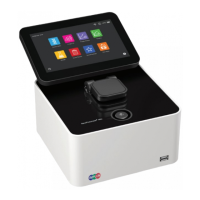NanoPhotometer
®
N120/NP80/N60/N50/C40 User Manual Version 4.3.1
84
PROTEIN ASSAYS
METHOD OVERVIEW
Protein concentration may be measured using colorimetric assays, in which certain reagents
are added to the protein solution to generate a colored product; either a protein-cupric ion
chelate as in the Biuret, Lowry, BCA assays or a protein-dye complex as in the Bradford
assay. In these colorimetric assays, the absorbance is measured in the visible range at the
appropriate wavelength for each assay and compared against a standard curve prepared by
serial dilution of a protein standard of known concentration. A linear, linear zero or 2
nd
order
regression analysis of the calibration standard data points is calculated by the
NanoPhotometer
®
. A correlation coefficient (R
2
) in the range of 0.95 to 1.00 indicates a good
fit to a straight line.
Bradford Assay
Method depends on quantifying the binding of a dye, Coomassie Brilliant Blue, to an
unknown protein and comparing this binding to that of a standard curve prepared from a set
of known protein of known concentrations at 595 nm. This standard is usually BSA (bovine
serum albumin).
Biuret Assay
Method depends on a reaction between cupric ions and peptide bonds in an alkali solution,
resulting in the formation of a complex absorbing at 546 nm.
Note: Biuret is only available for cuvette measurements (NP80 and C40).
BCA Assay
Method depends on a reaction between cupric ions and peptide bonds coupled with the
detection of cuprous ions using bicinchoninic acid (BCA), giving an absorbance maximum at
562 nm. The BCA process is less sensitive to the presence of detergents used to solubilize
membranes.
Lowry Assay
Method is based on the Biuret reaction. Under alkaline conditions the divalent copper ion
forms a complex with peptide bonds in which it is reduced to a monovalent ion. Monovalent
copper ion and the radical groups of tyrosine, tryptophan, and cysteine react with Folin
reagent to produce an unstable product that becomes reduced to molybdenum/tungsten
blue. The bound reagent changes color from yellow to blue. This binding is compared with
that obtained with a standard protein at 750 nm; this is usually BSA (bovine serum albumin).
Note: Detailed protocols are customarily supplied with these assay kits, and must be closely
followed to ensure that accurate results are obtained.

